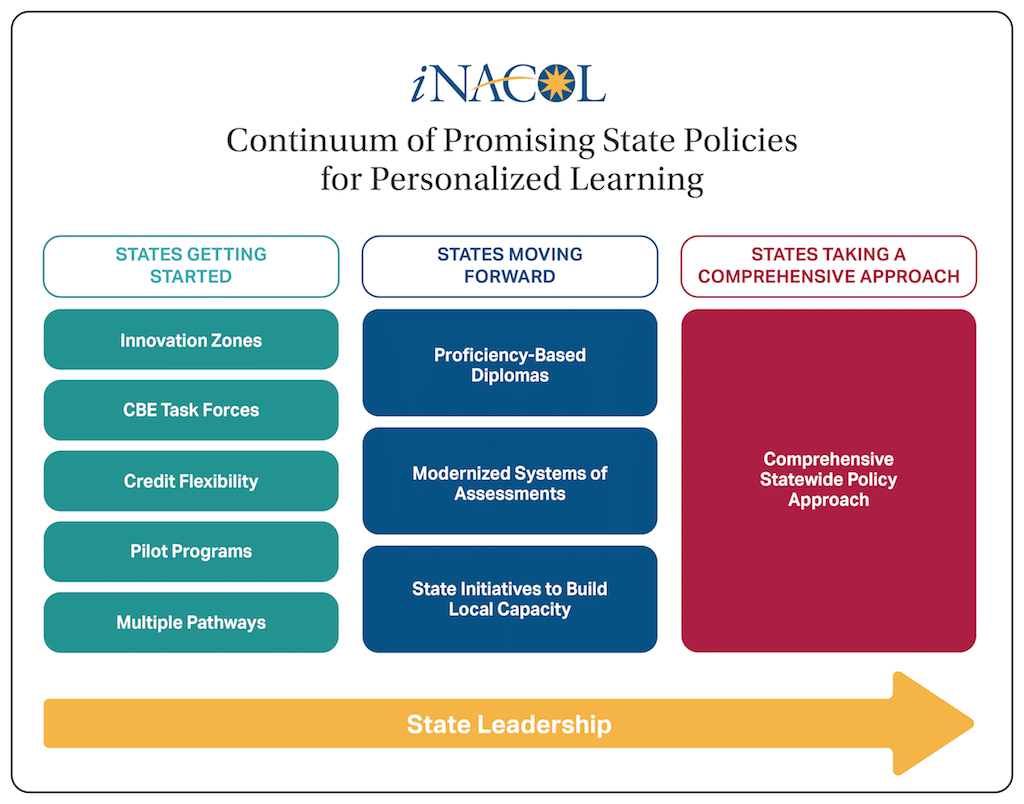Recommendations for State Policymakers to Build Competency-Based Systems
Education Domain Blog
Fully-developed, student-centered systems require significant shifts in policy and practice. They require the right balance of policies that create space for innovation and those that ensure equity with adequate supports and quality guardrails. No matter where a state is starting from, there are various entry points along a continuum for policymakers to support and build competency-based, K-12 education systems in their states.
iNACOL has released a new issue brief, State Policy & K-12 Competency-Based Education, which provides an overview of competency-based education, and provides state policy recommendations and resources for policymakers who are ready to enable and support competency education. In a previous blog, we explored the concept of state policies that enable personalized, competency education. In this blog, we will further explore the entry points along a continuum that state policymakers could pursue to advanced student centered learning.
States that do not yet have any enabling policies in place may wish to take incremental steps to create space for new learning models, while a state that already has made some progress may contemplate more comprehensive steps toward transformation. The graphic below summarizes the different entry points where policymakers can catalyze transformation of K-12 education in their state, with varying levels of state leadership:
States Getting Started: Creating Space for Competency-Based Systems
For states getting started, competency-based education task forces can help to identify policy barriers, advance the concept of competency education in the state and generate a feedback loop to state policymakers.
Credit flexibility policies can allow districts and schools to move away from seat time and to award credit for graduation based on demonstrated mastery.
Innovation zones provide pioneering school districts with flexibility from state policies and requirements in order to implement personalized, competency-based learning models.
Pilot programs support the examination of which strategies work in practice and lead to sharing and scaling of promising practices in other localities.
Policies that allow for multiple pathways to college and career readiness create opportunities for students to pursue their interests and gain real-world skills and experiences. These pathways could include: expanded learning opportunities, apprenticeships, community service, internships, independent study, online courses, community arts programs, private instruction, and career and technical and college-level coursework.
States Moving Forward: State-Led Strategies to Accelerate Systems Transformation
For states moving towards broader systems change, policymakers could establish policies on proficiency-based diplomas, which require students to demonstrate mastery of academic content standards before graduating. While not inherently competency-based (particularly if implemented as solely “credit by exam”), proficiency-based diplomas can encourage the adoption of personalized, competency-based learning by stipulating that graduation decisions be based on students demonstrating mastery of college- and career-ready standards, rather than on seat-time credits.
The Every Student Succeeds Act (ESSA) provides additional space for states to redesign their systems of assessments to better support student-centered learning. Balanced, innovative systems of assessments can empower educators, students and other stakeholders with multiple forms of evidence and timely feedback on student growth, readiness, depth of learning and mastery of competencies. In competency-based education, assessment is a positive experience for students because it is part of the learning process. Innovative systems of assessments incorporate formative, interim and summative measures and forms of evidence of student work.
ESSA allows for states to consider innovative assessment pilots with a smaller number of districts to help support competency-based education. State leaders could partner with districts and schools for the pilot that are beginning to lead the way on competency-based learning.
ESSA also gives states the space to rethink accountability through multiple measures, continuous improvement and reciprocal accountability. States have the opportunity to move from top-down accountability models that base high-stakes decisions on a single indicator of grade-level proficiency, to next generation accountability models that drive toward student mastery of a more meaningful definition of success aligned to the knowledge and skills students truly need to succeed in college, career and civic society.
As states begin to implement their ESSA plans, they may go back to the U.S. Department of Education for permission to amend their state plans. States can use the amendment process to continuously improve state systems of assessments and accountability to better meet the goals of equitable education systems that help all students succeed.
Comprehensive Statewide Policy Approach: Coherence Across Systems
Finally, states could take a comprehensive statewide policy approach with a combination of the aforementioned policies to build coherent, aligned systems built on shared goals for all students to succeed and thrive in college, career, and civic life with high-quality personalized, competency-based models and supports.
For example, Vermont has pursued a comprehensive statewide policy approach with proficiency-based graduation requirements, personalized learning plans, systems of assessments for learning, accountability for continuous improvement, flexible pathways and educator and school leader development initiatives. All of these components work together in a coherent manner to improve educational options and results for students.
Summary Recommendations
- Create policies to enable innovation zones and pilot programs to support districts or schools implementing competency-based systems.
- Host a Competency-Based Education Task Force to develop recommendations specific to your state context.
- Effectively communicate to parents and communities the benefits of competency-based learning models.
Resources to Learn More:
- iNACOL Issue Brief: State Policy & K-12 Competency-Based Education
- iNACOL – State Policy & K-12 Competency-Based Education
- iNACOL ‒ Fit for Purpose: Taking the Long View on Systems Change and Policy to Support Competency Education
- iNACOL ‒ Promising State Policies to Advance Personalized Learning
- iNACOL ‒ Meeting The Every Student Succeeds Act’s Promise: State Policy to Support Personalized Learning
- KnowledgeWorks ‒ A State Policy Framework for Scaling Personalized Learning
- CompetencyWorks ‒ Reaching the Tipping Point: Insights on Advancing Competency Education in New England
- National Governor’s Association ‒ Expanding Student Success: A Primer on Competency-Based Education
- Foundation for Excellence in Education ‒ Policy, Pilots, and the Policy, Pilots and the, Path to Competency-Based Education: A Tale of Three States
